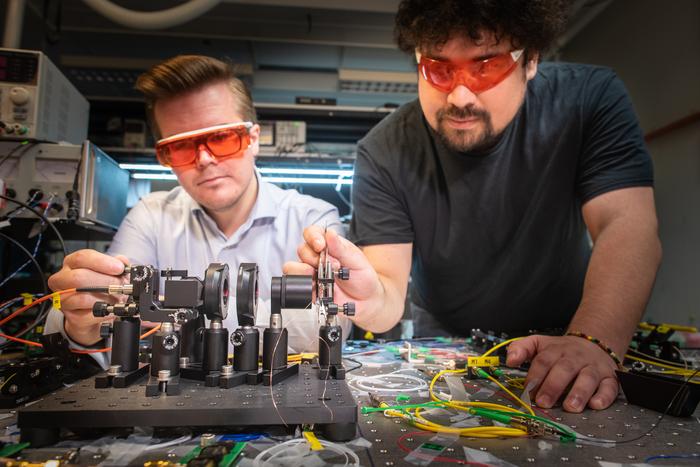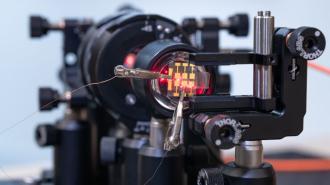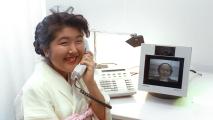In 54 BC, Julius Caesar sent a letter to Quintus Cicero, the less famous brother of the Roman statesman Marcus Cicero. Quintus’s camp was under attack from the Gauls, and Caesar’s letter informed Quintus that help was on the way. To keep the contents of the message safe from prying Gallic eyes, Caesar encoded it using a substitution cipher — one of the first documented instances of encryption used for military purposes.
Two millennia later, physicist Charles Bennett would also send another landmark encrypted message. But while Caesar had to resort to a spear to deliver his message — ordering it to be secretly thrown over Quintus’s battlements — Bennett sent his using photons of light.
Bennett, along with computer researcher Gilles Brassard, had devised a quantum cipher scheme, and in 1989, he sent the world’s first quantum cryptographic exchange. His interlocutors, “Alice” and “Bob,” were devices in a lab, and the message only covered a distance of 30 centimeters.
Even so, like Caesar before him, Bennett’s message represented a milestone moment in the history of cryptography.
Three decades after Alice and Bob used quantum physics to encrypt their message, one might wonder why quantum cryptography hasn’t become more widespread. With the promise of foolproof encryption, the technology could keep our bank accounts, medical records, and other important data safe from bad actors. Unfortunately, scaling quantum cryptography from the lab to the world has proven a tremendous challenge.
However, researchers out of Linkӧping University may have found an important piece to the puzzle. They’ve developed a new type of quantum random number generator, and they believe it can help bring quantum cybersecurity to the mainstream.
Encryption, with a light touch
Random number generators create encryption keys by which algorithms can scramble and later decipher information.
In many ways, they work like the simple codes we remember from grade school: A series of symbols create a key (like a decoder ring) to encrypt information (such as an in-class note) through an algorithm (substituting each letter of the alphabet with its corresponding symbol).
As long as the recipient has the same key as you, they can unscramble the note’s message and read it. (“Do you like like Becky? Yes / No.”)
The difference is that, unlike the decoder rings found in cereal boxes, random number generators create their keys from an unpredictable string of bits. These keys are used to encrypt data and decipher it once, and only once, before they are discarded. A quantum random number generator performs a similar task but generates its bits with photons — a mechanic that, as we’ll see, makes quantum cryptography unbreakable.
To develop their quantum random number generator, the Linkӧping researchers used perovskite light-emitting diodes (LEDs). They chose perovskite, a crystal-like mineral used in solar cells, because these LEDs are relatively cheap, can be integrated easily into other systems (like computers), and are more environmentally friendly than typical solid-state light sources.
To understand how the system works, let’s employ the help of the characters Alice and Bob (as is tradition in the field).
Alice wants to send a secret message to Bob, but they first have to create an encryption key. To begin that process, Alice breaks out her shiny new perovskite LED quantum random number generator and sends photons Bob’s way. She transmits those photons through a filter that polarizes them. These photons can be polarized rectilinearly (either horizontally or vertically, to represent a 1 or 0 respectively). They can also be polarized diagonally (left-right or right-left, again to represent a 1 or 0).
Bob receives and measures the photons with a polarizing beam splitter (you’ll need to clip a lot of cereal box tops to get one of these). This beam splitter comes equipped with two detectors, one rectilinear and the other diagonal. Due to the laws of quantum physics, Bob’s beam splitter must use one or the other to measure the incoming photons. It can’t use both at the same time. The device will have to guess which detector to use for each photon, and that means it will choose wrong occasionally.
That’s okay. Alice can contact Bob to tell him about the polarization scheme she sent. They can still create a single-use key by keeping the photons Bob’s device guessed correctly and discarding the rest. That random key can then be used to encrypt and then decipher Alice’s forthcoming message.
“In cryptography, it’s not only important that the numbers are random, but that you’re the only one who knows about them,” Guilherme Xavier, one of the study’s authors and a researcher at the department of electrical engineering at Linkӧping University, said. “With [quantum random number generators], we can certify that a large amount of the generated bits is private and thus completely secure.”
If the laws of quantum physics are true, it should be impossible to eavesdrop without the recipient finding out.
Guilherme Xavier
Alice and Eve
Crucially, Xavier adds, “And if the laws of quantum physics are true, it should be impossible to eavesdrop without the recipient finding out.” How can he be so sure? Because those laws guarantee that anyone trying to intercept the key will alter it in a detectable way.
Imagine the scenario above has a third character, the black-hat hacker Eve. Like Bob, Eve’s device must also guess how to measure each of the photons. But because she can’t communicate with Alice to double-check her guesses, Eve will be stuck with any mistakes she makes. She can’t discard them like Bob, so the task of creating a working key becomes immeasurably more difficult.
Also, by intercepting and measuring the photons, Eve risks “twisting” photons into new orientations. Each twist changes Alice’s original scheme, and when Alice and Bob perform their error-checking procedure, Eve’s tampering will be apparent. They can simply discard their key and try again.
Remember: No actual information has been exchanged between Alice and Bob at this point. They are simply creating a random, one-time key for encrypting and deciphering a message. Because Eve can never intercept the key in secret, Alice and Bob will always know if their key is compromised before sending any messages with it.
“The claim that quantum cryptography is secure is qualitatively different from all previous claims,” physicist Simon Singh writes in The Code Book. “Indeed, if a message protected by quantum cryptography were ever to be deciphered, it would mean that quantum theory is flawed, which would have devastating implications for physicists.”
To test their real-world perovskite LED system, the Linkӧping team used the National Institute of Standards and Technology (NIST) test suite for random number generators. Their results showed that their quantum random number generator passed the NIST tests and generated a high bit rate per second compared to similar devices.
They hope that these advantages will overcome the barriers to the widespread use of quantum cryptography.
“It’s possible to use, for example, a traditional laser for [quantum random number generators], but it’s expensive. If the technology eventually finds its way into consumer electronics, it’s important that the cost is kept down and that the production is as environmentally friendly as possible,” Feng Gao, another study author and a professor at the department of physics, chemistry, and biology at Linkӧping, said.
The researchers published their findings in the peer-reviewed Physics Communications.

A few quantum leaps still to go
Looking ahead, the researchers aim to improve their perovskite LED system. The operational lifetime of their LEDs was only 22 days, so the next step would be to extend that lifetime. The researchers also hope to make it more environmentally friendly by, for example, making the perovskite lead-free.
That would be an important step toward widespread quantum cryptography, but vast hurdles remain. To be useful, quantumly encrypted messages need to be transferable across long distances — a delicate task given photons’ tendency to scatter or be absorbed. To date, the record distance a quantum key has been distributed is 421 kilometers. An impressive achievement, but at only the width of a mid-sized state and with no way to regenerate signals without also corrupting them, it is not yet a practical application.
If these challenges can be overcome, however, it would mean the end to a struggle between codemakers and codebreakers that dates as far back as the Roman Empire.
“If quantum cryptography systems can be engineered to operate over long distances, the evolution of ciphers will stop. The quest for privacy will come to an end,” Singh writes. “Quantum cryptography would mark the end of the battle between codemakers and codebreakers, and the codemakers emerge victorious.”






